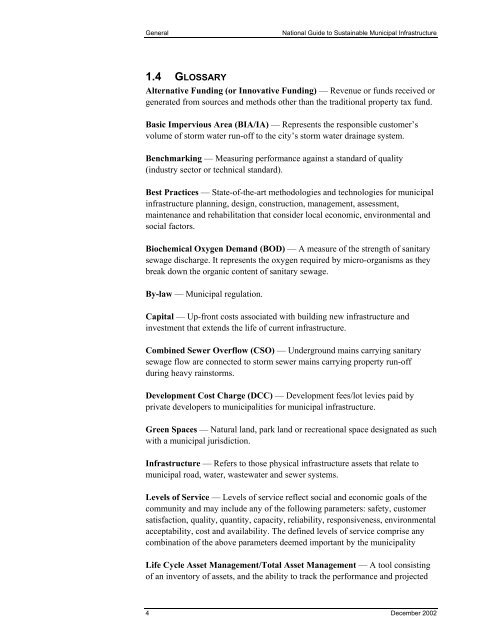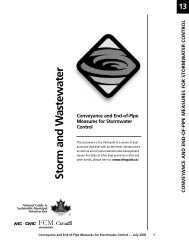ALTERNATIVE FUNDING MECHANISMS - FCM
ALTERNATIVE FUNDING MECHANISMS - FCM
ALTERNATIVE FUNDING MECHANISMS - FCM
You also want an ePaper? Increase the reach of your titles
YUMPU automatically turns print PDFs into web optimized ePapers that Google loves.
General National Guide to Sustainable Municipal Infrastructure<br />
1.4 GLOSSARY<br />
Alternative Funding (or Innovative Funding) — Revenue or funds received or<br />
generated from sources and methods other than the traditional property tax fund.<br />
Basic Impervious Area (BIA/IA) — Represents the responsible customer’s<br />
volume of storm water run-off to the city’s storm water drainage system.<br />
Benchmarking — Measuring performance against a standard of quality<br />
(industry sector or technical standard).<br />
Best Practices — State-of-the-art methodologies and technologies for municipal<br />
infrastructure planning, design, construction, management, assessment,<br />
maintenance and rehabilitation that consider local economic, environmental and<br />
social factors.<br />
Biochemical Oxygen Demand (BOD) — A measure of the strength of sanitary<br />
sewage discharge. It represents the oxygen required by micro-organisms as they<br />
break down the organic content of sanitary sewage.<br />
By-law — Municipal regulation.<br />
Capital — Up-front costs associated with building new infrastructure and<br />
investment that extends the life of current infrastructure.<br />
Combined Sewer Overflow (CSO) — Underground mains carrying sanitary<br />
sewage flow are connected to storm sewer mains carrying property run-off<br />
during heavy rainstorms.<br />
Development Cost Charge (DCC) — Development fees/lot levies paid by<br />
private developers to municipalities for municipal infrastructure.<br />
Green Spaces — Natural land, park land or recreational space designated as such<br />
with a municipal jurisdiction.<br />
Infrastructure — Refers to those physical infrastructure assets that relate to<br />
municipal road, water, wastewater and sewer systems.<br />
Levels of Service — Levels of service reflect social and economic goals of the<br />
community and may include any of the following parameters: safety, customer<br />
satisfaction, quality, quantity, capacity, reliability, responsiveness, environmental<br />
acceptability, cost and availability. The defined levels of service comprise any<br />
combination of the above parameters deemed important by the municipality<br />
Life Cycle Asset Management/Total Asset Management — A tool consisting<br />
of an inventory of assets, and the ability to track the performance and projected<br />
4 December 2002
















